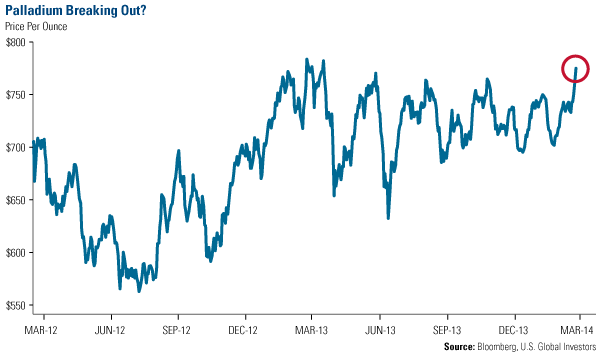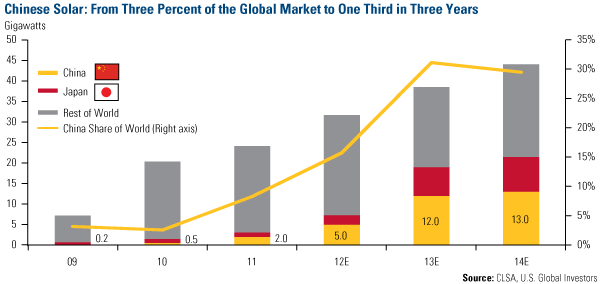Making Green from Gold, Palladium and Pollution
By Frank Holmes
CEO and Chief Investment Officer
U.S. Global Investors
March 07, 2014
Gold’s Bull Days Are Back?
Gold is coming back with a vengeance, experiencing a clear recovery and grabbing the attention of market cynics. Analysts from Noruma Securities even upgraded its outlook for gold, expecting bullion to climb over the next three years, according to Barron’s.
 |
Nomura analysts attribute their increased gold forecast to real interest rates that “don’t seem to be heading anywhere at the moment.” In addition, there appears to be “long-term demand support from Asian nominal income growth, an evolving post-QE macroeconomic environment and lower disinvestment potential.”
Gold is also gleaming a little brighter in Japan, as its central bank announced that monetary policies will remain very accommodative. With a weakening yen, gold will likely be seen as a store of value for Japanese investors.
Palladium Near Its Highest Level in Almost a Year
Two global events colluded this week that dramatically affected the palladium and platinum market. The situation in Ukraine and Russia along with six-week-long strikes in South Africa began raising concerns that these palladium-rich countries may not be able to continue supplying the commodity at normal levels.
Currently South Africa supplies around 37 percent of the world’s palladium; Russia supplies close to 40 percent of the world’s palladium.
What does this all mean for the palladium and its sister platinum? It seems that fear surrounding the international political landscape is helping to push the precious metals prices higher and higher.
You can see the effect the political landscape is having on palladium. Over the past year, the metal has mainly traded sideways, but this week hit its highest level in almost a year. The precious metal reached $775 per ounce while its sister, platinum, climbed to nearly $1,500 an ounce.
In January, I indicated that platinum and palladium looked extremely compelling. There were supply and demand drivers I felt would drive the metals higher.
Just this week, the U.S. Mint is “ending a four-year exit from the market” by selling one-ounce American Eagle platinum bullion coins, writes Frank Tang from Reuters. According to a wholesaler this week, initial demand is strong, as 1,000 coins have already been scooped up.
Like I discussed with Resource Investing News at the Vancouver Resource Investment Conference, industrial demand has been gaining strength. Take rising automobile sales in the U.S. that I talked about a few months ago. With interest rates on car loans so low, Americans have been replacing their clunkers with more fuel efficient cars, which is positive for platinum and palladium.
It’s a similar story in emerging markets. In Africa, the GDP without a leveraged economy is still growing at 5 percent, and you definitely need platinum and palladium for their vehicles, even if they are diesel.
In China, vehicle sales last year rose faster than expected, climbing nearly 14 percent compared to a year earlier, according to the China Association of Automobile Manufacturers. The country is already the biggest automobile market in the world and millions of new cars on the roads add up fast.
We’re pleased that our technical models signaled initial bullish signs, as our palladium- and platinum-related holdings helped boost the returns of the Gold and Precious Metals Fund (USERX) and the World Precious Minerals Fund (UNWPX.
Renewable Energy Could Get You More Green
In our webcast this week, Brian Hicks, portfolio manager of the Global Resources Fund (PSPFX), talked about four opportunities he sees in resources over 2014.
One relates to China’s focus on alternative energy.
See the other three opportunities now.
In BP’s latest Energy Outlook 2035, you can see the incredible long-term growth anticipated in the renewable energy industry. In terms of volume growth, China is expected to surpass the European Union countries by 2035. Based on this secular transformation, the local clean energy sector should continue to benefit.
Specifically, wind power and solar look especially attractive, especially given the excessive pollution in the Asian giant. Take a look at CLSA data: In 2009, the country had about 0.2 percent of the global market. By 2014, it’s estimated to grow to one third of the global market.
China isn’t the only country with a growing renewable energy market. After the massive earthquake hit Japan in 2011, the solar market is taking off there too.
If you were too busy to tune into our webcast this week, you missed a good discussion among Brian Hicks, John Derrick and me. It was an hour chock-filled with investing ideas in the U.S. market, emerging countries, resources and gold. However, it’s not too late to watch the replay at your leisure this weekend.

















